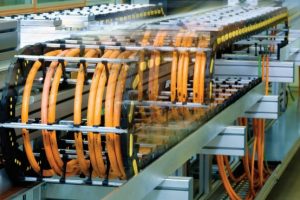 The basics of cable load capacities for automated systems
The basics of cable load capacities for automated systems
June 9, 2016 REDWIRE is news you can use from leading suppliers. Powered by FRASERS.
Posted by Lapp Canada Inc
Lapp Canada designs and manufactures durable and reliable electrical connectivity solutions that ensure maximum uptime f... Read more
Subscribe
Free REDWIRE e-newsletter

The cables used in cable tracks for complex automated systems must meet a variety of demanding requirements. They can be subject to enormous loads, and they must be durable, flexible, lightweight and have the ability to fit into tight spaces. A variety of specialized cables are available to meet these requirements. To select the right cable for the job requires an understanding of the physical forces involved with the application.
To help in this regard, Lapp Group recently released a white paper that explains the fundamentals of cable load capacities. Entitled ”Cable basics: Understanding dynamic load-bearing capacity”, the paper is written by Lucas Kehl, Lapp Group’s product manager.
Load types
A number of physical forces may act on cables used in automated systems. They include push and pull loads, bending loads and torsion loads.
- Push and pull loads act in the longitudinal direction of the wire. These loads can be static, dynamic or a combination of the two.
- There are three distinct types of bending loads to consider when it comes to choosing cable. Simple flexing involves flexing a cable at a single, defined break point. Continuous flexing occurs along the entire length of the cable. Guided flexing involves continuous flexing using a guiding component such as a pulley.
- Lastly, torsion loads involve a twisting force on cables, and are often involved in robotic applications.
Cable solutions
Consideration of the loads involved with the application will help determine the appropriate cable choice. For instance, cables used in tracks are subjected to continuous flexing. For these applications, Lapp can offer OLFLEX FD and OLFLEX CHAIN power and control cables. They are specifically designed to handle these forces.
When it comes to torsion forces, Lapp can supply robotic cables. As opposed to continuous flex cables where the conductors are stranded tightly to allow movement of individual conductors, robotic cables have longer lay lengths.
In addition to load bearing capacities, Lapp can supply cables designed to offer the lightweight, durability, small minimum bending radius, and other requirements for automated systems. They include cables that feature special materials, constructions, production methods and rigorous testing.
For more information, visit the Lapp Canada website.
Share
Posted by Lapp Canada Inc
Lapp Canada designs and manufactures durable and reliable electrical connectivity solutions that ensure maximum uptime f... Read more